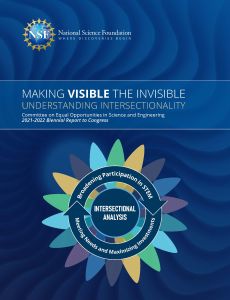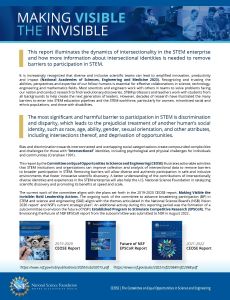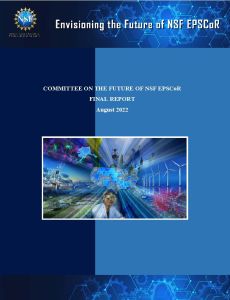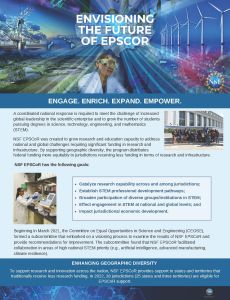Committee membership
Membership details
Committee members, currently comprised of 19 individuals, come from diverse STEM disciplines, drawn from diverse institutions in higher education, industry, government and nonprofit sectors. Its membership also reflects the racial, ethnic and gender diversity of the country's citizenry and includes persons with disabilities. Members of the committee typically serve a three-year term.
A full committee meeting is held three times a year to review and evaluate policies and program opportunities focused on the state of participation and advancement of women, underrepresented racial and ethnic groups, and persons with disabilities in education, training and science and engineering research. Based on the findings, the committee makes recommendations to NSF for improving the levels of participation of underrepresented groups in STEM professions.
Committee members also interact with other federal agencies — such as the U.S. Department of Agriculture, National Institutes of Health, the Smithsonian Institution and the White House Initiative on Advancing Educational Equity, Excellence, and Economic Opportunity through Historically Black Colleges and Universities — in forging ongoing collaborative insights about efforts to broaden participation by underrepresented groups in the nation's STEM workforce. CEOSE is a congressionally mandated advisory committee to the National Science Foundation.
Current roster
Click on a member's name to view their biography.
- Suzanne Barbour (CEOSE Vice Chair)
- John M. M. Anderson
- Gilda A. Barabino
- Sean Chandler
- Tabbetha A. Dobbins
- Barbara Endemaño Walker
- Ann Quiroz Gates
- Sandra Graham
- Peter Hauser
- Rupa Iyer
- Okhee Lee
- Cynthia Lindquist
- James R. Martin, II
- Vernon Morris
- Timothy M. Pinkston
- Susan Renoe
- Manuel Rodriguez Martinez
- David Kwabena Wilson
CEOSE biennial reports to Congress
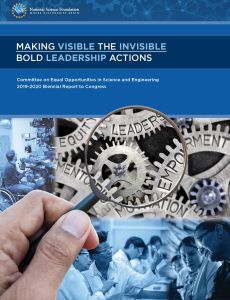
Making visible the invisible: Bold leadership actions 2019–2020
In this report, the Committee on Equal Opportunities in Science and Engineering recommends the National Science Foundation demonstrate and promote bold leadership actions to create, integrate and make visible elements within and across its programs to enhance broadening participation of underrepresented and underserved groups in STEM.
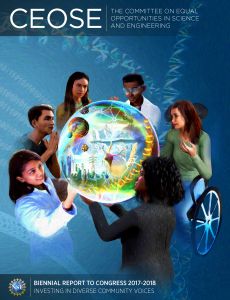
Investing in diverse community voices 2017–2018
In this report, CEOSE advises NSF to give increased attention to including diverse community voices across its research and education portfolios through community-driven projects. They suggest NSF fund research that focuses on building inclusive, community-engaged STEM communities to promote STEM participation on the ground and at all ages, as well as reap the scientific benefit of the insights of people from diverse settings, neighborhoods and circumstances in the innovation cycle.

Accountability for broadening participation 2015–2016
In this report, CEOSE recommends developing an accountability framework for assessing the development of the bold new initiative advocated for in its first two reports and for assessing NSF's overall broadening participation portfolio.
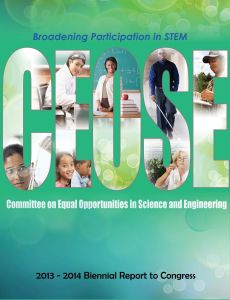
Broadening participation in STEM 2013-2014
In a follow-up to their previous report, the committee recommends five practical components to further strengthen broadening participation of underrepresented groups in STEM.
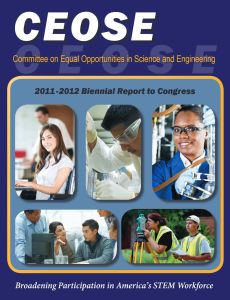
Broadening participation in America's STEM workforce 2011–2012
In this report, CEOSE recommends NSF implement a bold new initiative, focused on broadening participation of underrepresented groups in STEM, similar in concept and scale to NSF's centers, that emphasizes institutional transformation and system change; collects and makes accessible longitudinal data; defines clear benchmarks for success; supports the translation, replication and expansion of successful broadening participation efforts; and provides significant financial support to individuals who represent the broadened participation sought by NSF.
Special report
Envisioning the Future of NSF EPSCoR (2022)
The Committee on Equal Opportunities in Science and Engineering established a subcommittee to conduct a visioning activity for the future of NSF EPSCoR. The subcommittee recently completed its report and made eight recommendations to inform the envisioning of the future of NSF EPSCoR. Click to view the full report or the two-page summary. Also, please watch the videos about the report below.
Meeting information
2024 Meetings
- June 2024
- October 2024
2023 Meetings
2022 Meetings
2021 meetings
2020 meetings
2019 meetings
2018 meetings
2017 meetings
2016 meetings
2015 meetings
2014 meetings
- CEOSE Meeting Minutes - February 2014
- CEOSE Meeting Minutes - June 2014
- CEOSE Meeting Minutes - October 2014
NSF staff
- Alicia J. Knoedler (Executive liaison)
- Bernice Anderson (Executive secretary)
- Jolaina Jeff Cartier (Staff associate)
- Una Alford (Program analyst)





